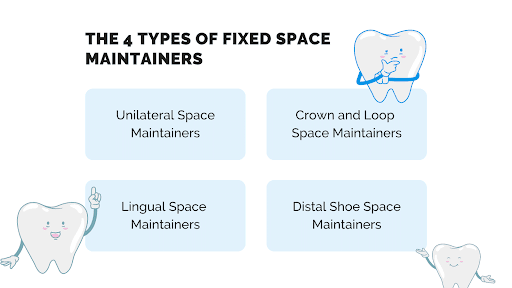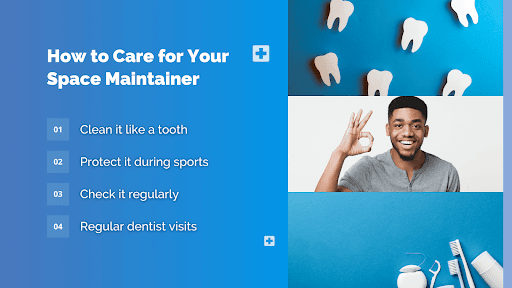As your child loses their first baby tooth, you both eagerly await the arrival of their adult one. But what if it takes longer than you expected?
As early orthodontics progresses and adult teeth are ready for prominence, space maintainers step in to hold the fort.
Here’s the scoop on space maintainers and how they offer a game-changing solution to keeping your children’s smiles on track!
Table of Contents
What is a Dental Space Maintainer?
If a child loses a primary tooth prematurely, the surrounding teeth may shift into the open space, potentially leading to alignment problems when the permanent tooth erupts.
The purpose of a dental space maintainer is to prevent such movement by keeping the dental space open. In this custom-made device, your child’s permanent teeth will be able to grow correctly in their correct position, preventing more complex orthodontics later in life.
Some children lose their first baby teeth as early as 4 years old!
Source: Cleveland Clinic
The 4 Types of Fixed Space Maintainers

Unilateral Space Maintainers
A unilateral space maintainer is used when a tooth on one side of the mouth is lost prematurely. The appliance consists of a band attached to a permanent tooth and a wire loop extending across the gap to prevent the neighboring tooth from shifting.
Crown and Loop Space Maintainers
Typically, orthodontists use crown and loop space maintainers when a primary molar has fallen out prematurely. During the procedure, a crown is fitted over the tooth adjacent to the empty space with a stainless steel loop extending into the missing tooth’s space, preserving it for the unerupted permanent tooth.
Lingual Space Maintainers
In lingual space maintainers, “lingual” refers to the tooth closest to the tongue. This dental appliance is connected to both molars on both sides and is used when multiple teeth are missing.
Distal Shoe Space Maintainers
When a primary molar is lost without a permanent successor, distal shoe space maintainers are used to keep the space open. They are inserted under the gum line to keep the space open.
Removable Space Maintainers
Many of the features of removable space maintainers are similar to those of retainers. They’re usually acrylic and often contain artificial teeth for filling in any gaps. Because they maintain your smile’s aesthetic while serving their practical purpose, they are particularly useful in highly visible areas of your mouth.
Because removable space maintainers are removable, they require careful management to ensure they are not lost or damaged. These maintainers are best suited for older children or adults who can reliably handle and care for orthodontic devices.
How an Orthodontist Uses a Space Maintainer in Pediatric Dentistry
Why Your Child’s Teeth May Need a Space Maintainer
You can think of your child’s baby teeth as the opener for the adult teeth. They set the stage, preparing everything for the adult teeth to appear.
But what happens when the opening act finishes too early and the main event isn’t ready to begin?
You’ve got this gap that other teeth might start shifting into, causing problems once the adult tooth finally shows up and takes its place. That’s precisely the issue with a baby tooth falling out early – the adult tooth isn’t ready yet!
Space maintainers serve as placeholders until the adult tooth is ready to emerge.
The Space Maintainer Placement Process
A pediatric dentist will inspect your child’s teeth to determine if a space maintainer is necessary. If so, they will get an impression of the mouth. Imagine it as a 3D snapshot of all the teeth and how they fit together.
Afterward, the impression will be sent to a dental lab, which turns it into a custom-fit space maintainer for your child. Your dentist then places the space maintainer in your child’s mouth, ensuring it keeps that space open.
Removing Your Child’s Space Maintainer
Space maintainers are finally ready to step off stage when your adult tooth is ready to emerge. To remove the space maintainer, your dentist will use special tools. The process may involve unfastening a band or clipping a wire, depending on the type of space maintainer.
You might feel a weird sensation in your mouth, but the entire process shouldn’t be painful. It’s like taking off a piece of jewelry.
Space Maintainer FAQ
How Long Will My Child Wear Their Space Maintainer?
In most cases, your child will need to wear a space maintainer until permanent teeth start to erupt, which means they poke through the gums.
There is no set schedule for the eruption of teeth. For some children, it may take a couple of months, while for others, it might take a couple of years.
How to Care for Your Space Maintainer

- Clean it like a tooth: As with regular teeth, the space maintainer needs to be brushed regularly. Make sure your child brushes around it while brushing their teeth.
- Protect it during sports: Make sure that the space maintainer and your child’s other teeth are protected during sports by wearing a mouth guard!
- Check it regularly: Keep an eye on the space maintainer regularly, and contact your dentist if it is loose or broken.
- Regular dentist visits: Ensure the space maintainer is doing its job by visiting the dentist regularly so you can catch any potential problems early.
Foods to Avoid With Space Maintainers

These foods and snacks won’t work with your child’s space maintainer:
- Sticky candy: Caramels, taffy, and gummies, for example, can stick to your teeth and pull on your appliance.
- Hard food: The space maintainer may be damaged by hard foods, such as hard candies, ice cubes, or super crunchy vegetables and fruits.
- Chewy food: Some types of meat, chewy bread, and dried fruits can be tricky, as they can yank on the space maintainer.
- Popcorn: A popcorn kernel can get stuck and cause discomfort or damage to a space maintainer.
- Sugary drinks: A sugary drink can promote tooth decay around the space maintainer, even though it is not a food.
How Much Do Space Maintainers Cost?

Several factors determine the cost of space maintainers:
- Geographical location
- The types of space maintainers
- The location of the maintainer (for example, on the upper or lower jaw, or both)
The cost of a space maintainer typically ranges from a few hundred to over a thousand dollars. Fortunately, dental insurance often covers at least part of the cost.
Do Space Maintainers Help Adult Teeth, Too?
Adults can totally use space maintainers!
When you lose a tooth but can’t get a dental implant immediately (maybe it’s healing), a space maintainer will hold down the fort and prevent other teeth from shifting into the vacant space.
Why is My Dental Space Maintainer Causing Pain?
A space maintainer may cause pain for several reasons.
Like a new pair of shoes, sometimes it takes some time to break in a space maintainer.
Continuing pain may indicate something else is wrong. The space maintainer might be rubbing against the gums or other parts of the mouth, causing irritation. It might not fit properly, or it might have been damaged.
A space maintainer may also cause inflammation of the gum tissue around it, especially if food particles become stuck and aren’t cleaned properly.
A dentist can examine things, ensure the space maintainer is fitted correctly, and address any problems. If the space maintainer continues to cause discomfort, schedule an appointment.
What if My Space Maintainer Fell Out?
Responding quickly and appropriately is crucial if your space maintainer falls out.
Locate the space maintainer and store it safely. Refrain from attempting to reinsert the appliance, as incorrect placement can lead to further problems.
You should then contact your dental healthcare provider immediately. They will advise you on the steps you need to take and arrange an appointment as soon as possible. If the appliance is not installed within a short period, the gap will start closing.
To prevent further disruptions to the area, maintain proper oral hygiene before your appointment and exercise extra caution while eating.
If the original appliance has dislodged, the dentist will either reposition it or decide to replace it, depending on the reasons for the dislodgement and the appliance’s condition.
Unlock Your Child’s Perfect Smile With the Magic of Space Maintainers!
Contact Loudoun Orthodontics if orthodontic care is the solution to your dental woes. Whether you want to learn more about the benefits of orthodontic care or have questions about the process, use our live chat or call (703) 858-0303 or send us a message through our Contact Us page to connect with our friendly staff today and book a complimentary orthodontic consultation!
Our office, located at 19465 Deerfield Ave. Suite 304 Lansdowne, VA 20176, proudly serves the Lansdowne, VA area. So, if you’re residing in Ashburn, Sterling, or Leesburg and are looking for one of the best orthodontists in Virginia, don’t hesitate to visit our office!
We also invite you to keep up with our blog to get answers to many of the frequently asked questions about maintaining your perfect smile, and follow us on Facebook and Instagram to become a part of our smiling community!
References
- “Bracing for the Fallout: When Do Kids Lose Their Teeth?” Cleveland Clinic, health.clevelandclinic.org/when-do-kids-start-losing-teeth/#. Accessed 3 Aug. 2023.

